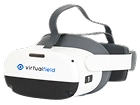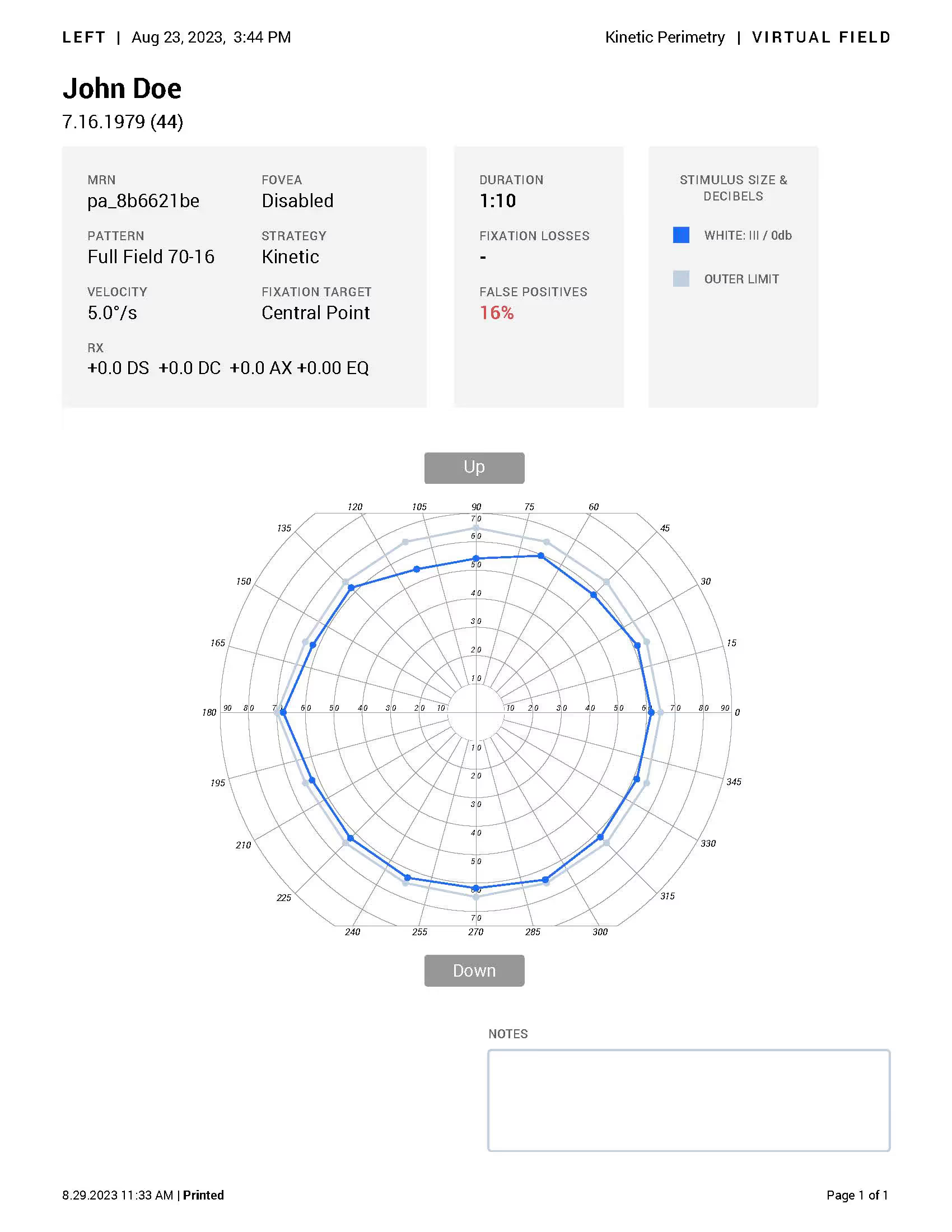Kinetic perimetry — often referred to as the Goldmann kinetic visual field test — uses a moving stimulus to reveal subtle and significant visual field defects. This test is especially effective for conducting a thorough peripheral field assessment, helping you detect conditions like glaucoma, stroke, and optic neuropathy before the patient experiences noticeable symptoms. With Virtual Field’s virtual kinetic perimeter, you can perform this dynamic test using a portable Goldmann device that fits into any modern practice setting.
This test assesses your patient’s entire visual field to identify peripheral vision loss and central scotomas. Kinetic perimetry is ideal for Virtual Field — a goldmann perimetry alternative device. Our high-resolution screen, automated eye-tracking, and real-time measurements translate to accurate data for quick interpretation and a smooth workflow.
What Is the Goldmann Kinetic Visual Field Test? (Overview)
In kinetic perimetry, a suprathreshold stimulus is moved across the visual field, starting outside its edge. The patient watches the stimulus move while the perimeter maps eye movements. This technique reveals the approximate size and location of scotomas to help diagnose glaucoma, macular degeneration, optic nerve damage, and other common conditions.
The Goldmann perimeter was first developed in 1945. In its day, this manual technique was an advanced method for mapping visual fields, but of course, it’s since been refined.
Virtual Field’s VF3 Pro advances kinetic visual testing with automated eye tracking and immediate data capture. This virtual kinetic perimeter transforms how practices conduct dynamic field assessments. It’s the first portable Goldmann device of its kind, eliminating the space and labor constraints of traditional perimeters.
Academic references and clinical validation
Outside research shows that using virtual reality for kinetic perimetry is comparable to using a Goldmann kinetic perimeter in results, but superior in accessibility.
When compared to static perimetry, kinetic visual field testing is shown to provide quality results — especially at the arcuate border.
Research shows that kinetic visual field testing is useful for patients with severe visual and neurologic deficits or rare genetic conditions like choroideremia.
Virtual Field is proud of its commitment to the highest security and quality assurance standards. We are SOC 2 Type 2, HIPAA, FDA, and Health Canada compliant.

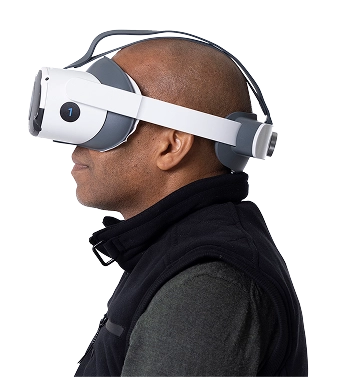
30 days free.
No strings attached.
We are confident you’ll love Virtual Field just like the 2,000 doctors who have already made the switch.
The Virtual Field Kinetic Perimetry Exam at a Glance
Sometimes called the Goldmann perimetry test, the kinetic visual field exam measures peripheral vision by tracking eye movements as a patient views a moving stimulus. This test is especially useful to detect blind spots that static tests might miss. During this exam, the VF3 Pro allows you to watch the patient’s eye movements in real-time using a camera. This capability is as close to a real-world vision test as it’s possible to get.
This test does require more patient cooperation and understanding than other exams, so it may be time-consuming or limiting for patients with language or physical barriers.
The Virtual Field headset uses real-time eye tracking and provides an intuitive interface for both clinician and patient. This allows you to conduct a peripheral field assessment that feels natural — as close to real-world vision testing as it gets.
Pros and cons of the Kinetic Visual Field Test
The pros and cons that follow can help guide you toward the ideal scenarios to incorporate this test into your patients' diagnostic assessments.
Pros
This exam tracks both central and peripheral vision for a more comprehensive view of the visual field.
The moving target simulates real-world conditions, producing peripheral field assessments with high clinical relevance.
Some studies indicate that kinetic testing is more effective at identifying early peripheral vision loss than static tests.
Works seamlessly with a virtual kinetic perimeter like the Virtual Field VF3 Pro.
Cons
Kinetic testing takes longer than other visual field exams, which may lead to patient fatigue.
Patient cooperation is mandatory, so those who struggle with fatigue, attention, anxiety, or disabilities may find this test challenging.
Small defects may still go unnoticed. This exam is best suited for identifying more significant defects in the peripheral vision.
Other tests are more sensitive to central vision, so patients with subtle defects may need additional testing.
Conditions Diagnosed with the Goldmann Kinetic Visual Field Test
Because the test is ideal for mapping how patients respond to dynamic stimuli across the entire field of vision, it functions as both a diagnostic and monitoring isopter mapping tool — especially in progressive or neuro-ophthalmic conditions.
Glaucoma
Peripheral vision loss is often one of the first signs of glaucoma. Kinetic testing excels at identifying blind spots in the peripheral vision, especially at the edge of the visual field.
Optic Neuropathy
Kinetic testing is particularly useful for identifying vision loss from optic neuropathies, such as ischemic optic neuropathy or optic neuritis, by detecting early peripheral vision defects.
Stroke
Patients who have suffered a stroke or other cerebrovascular events often experience hemianopia or quadrantanopia. The kinetic exam can map out the loss of peripheral vision, which is crucial for understanding the extent of brain damage.

~800K
Nearly 800,000 people in the U.S. experience a stroke each year
2 in 3
Up to 2 in 3 stroke survivors in Canada have some form of vision problem.
Diabetic Retinopathy
As many as 26% of people with diabetes will develop diabetic retinopathy, which can lead to peripheral vision effects. Kinetic testing helps reveal these defects, especially those that aren’t evident using static tests.
Macular Degeneration
For most patients with age-related macular degeneration, scotomas first appear in the central vision. You may find that kinetic testing is an effective way to map these blind spots, especially with more significant defects.
Autoimmune Conditions
These conditions, especially multiple sclerosis, can lead to optic nerve damage. Kinetic testing helps identify the extent of this damage and inform treatment.
Other Conditions
Kinetic visual field testing can also be used to monitor or diagnose:
- Retinal vein/artery occlusion
- Retinal detachment
- Retinitis pigmentosa
- Pituitary tumors
- Temporal arteritis
Example Goldmann Perimetry Reports
30 days free.
No strings attached.
We are confident you’ll love Virtual Field just like the 2,000 doctors who have already made the switch.
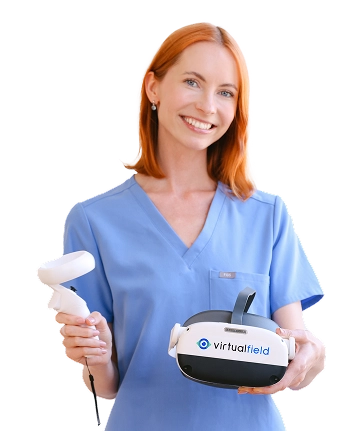
Kinetic Visual Field Tester Price
When considering your kinetic visual field tester price options, it's crucial to consider the full range of testing devices available on the market. A traditional tabletop device, such as the Goldmann perimeter, may require an upfront cost of $2,500 to $6,000. A new Haag-Streit Octopus 900 Pro costs around $35,500.
Alternatively, a Goldmann perimetry alternative device and modern VR-based solution, such as the Virtual Field Pro, delivers Goldmann-style kinetic perimetry in a portable headset at a low, affordable monthly subscription cost with no additional hardware maintenance requirements. By replacing bulky legacy equipment with advanced wearables, clinics can expand access to kinetic visual field exams without the high overhead or space requirements, giving more patients the benefits of comprehensive kinetic testing at a sustainable price.
Billing and Coding for Kinetic Visual Field Testing
Whether you use traditional Goldmann visual field assessments or a goldmann perimetry alternative device like our VF3 Pro, kinetic testing is billable to insurance.
CPT codes 92082 and 92083 apply to Goldmann kinetic visual field exams whether conducted manually or with a virtual kinetic perimeter like the VF3 Pro. For an intermediate exam with two isopters, use CPT code 92082. For extended exams with 3 or more isopters and additional details, use CPT code 92083.
Intermediate exams are reimbursed between $19 and $60, while extended tests are between $40 and $90 per exam. Refer to the Medicare Physician Fee Schedule (MPFS) for fee details, and remember that your location, practice setting, modifiers, and other details will impact your reimbursement amount.
When is kinetic testing required?
Use the kinetic visual field exam to screen patients with suspected or known glaucoma, stroke, pituitary tumors, or optic neuropathy. This test is beneficial among patients who have defects in their peripheral vision or complain of tunnel vision. For patients with progressive conditions, you may wish to repeat this exam regularly to collect data about how the patient’s visual field changes over time.
Is the Goldmann perimetry test required for driver’s licenses?
No, this exam isn’t standard for driver’s license evaluations. That said, peripheral vision is crucial to licensing in all states, and patients with suspected or diagnosed peripheral vision loss may need additional testing before getting a driver’s license. In these cases, the Esterman or FullField 120 exams are usually recommended.
Start Kinetic Testing with the Virtual Field Kinetic Perimeter
The Virtual Field kinetic perimeter modernizes the traditional Goldmann kinetic visual field exam, bringing real-time tracking, portability, and improved patient comfort to your workflow. With this portable Goldmann device, you can provide dynamic assessments that detect peripheral and central vision loss earlier — without the need for a dedicated testing room.
The kinetic visual field exam provides a dynamic, real-world assessment of visual function. You can use it to diagnose and monitor a whole host of conditions, and with Virtual Field’s accurate, automated eye-tracking technology, your workflow will be even faster. Patients prefer our comfortable, portable headset over bulky tabletop machinery, so you can provide a better patient experience while collecting all the data you need to make informed treatment decisions.
Want all 23 exam guides in one place?
Download our comprehensive guide for 160+ pages of insights.
FAQs
1. How does a virtual Goldmann kinetic visual field test work without a bowl perimeter?
2. What patient groups still require a kinetic visual field instead of static tests?
3. Which CPT code covers a virtual Kinetic Goldmann exam?
4. How long does a Goldmann-style test take on Virtual Field?
5. Can I adjust the stimulus speed and size?
6. Does the device export an isopter plot for the EMR?
Ready to get started?
Schedule a demo or begin your 30-day free trial of Virtual Field to try our EOM exam in your practice.
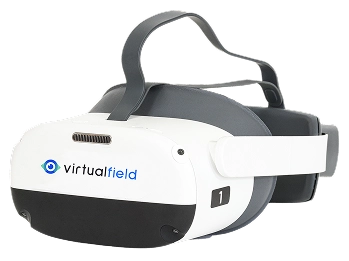
Questions? Contact sales@virtualfield.io talk to a Virtual Field expert today.

